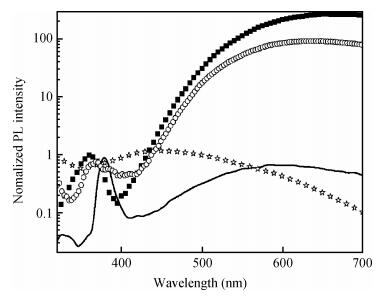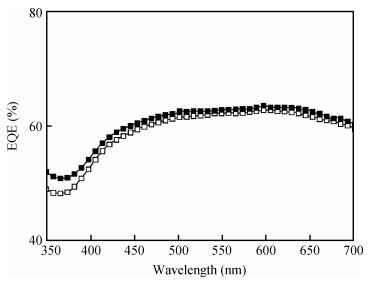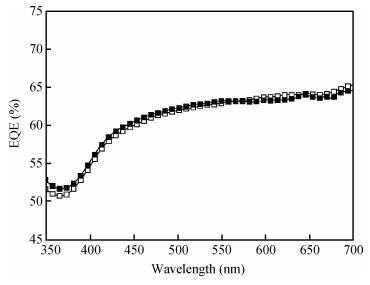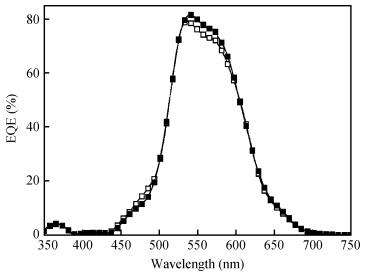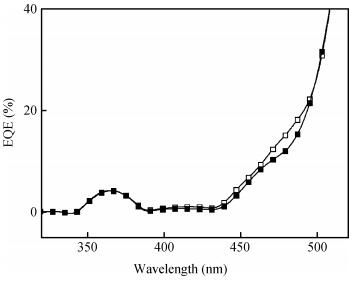| Citation: |
Yao Zhu, A. Apostoluk, Shibin Liu, S. Daniele, B. Masenelli. ZnO nanoparticles as a luminescent down-shifting layer for photosensitive devices[J]. Journal of Semiconductors, 2013, 34(5): 053005. doi: 10.1088/1674-4926/34/5/053005
****
Y Zhu, A. Apostoluk, S B Liu, S. Daniele, B. Masenelli. ZnO nanoparticles as a luminescent down-shifting layer for photosensitive devices[J]. J. Semicond., 2013, 34(5): 053005. doi: 10.1088/1674-4926/34/5/053005.
|
ZnO nanoparticles as a luminescent down-shifting layer for photosensitive devices
DOI: 10.1088/1674-4926/34/5/053005
More Information
-
Abstract
The optical properties of ZnO nanoparticles (NPs) fabricated by three different methods were studied by the UV-excited continuous wave photoluminescence in order to estimate their down-shifting (DS) efficiency. Such a luminescent layer modifies the incident solar radiation via emitting wavelengths better matching the spectral response of the underlying photosensitive device (photodiode), thereby increasing its efficiency. Some of the studied ZnO NPs were subsequently deposited on the front side of commercial silicon photodiodes and the external quantum efficiency (EQE) characteristics of the final devices were measured. Through comparison of the photodiode's EQE characteristics before and after the deposition of the ZnO NPs layer, it was concluded that for the photodiode with a low UV sensitivity (about 8%), the ZnO luminescent layer produces a down-shifting effect and the EQE in the UV and blue range improves by 16.6%, while for the photodiodes with a higher initial UV sensitivity (about 50%), the EQE in this range decreases with the ZnO layer thickness, due to the effects competing with DS, like the diminution of the ZnO layer transmittance and an increasing diffusion. -
References
[1] Shockley W, Quiesser H J. Detailed balance limit of efficiency of p-n junction solar cells. J Appl Phys, 1961, 32(3):510 doi: 10.1063/1.1736034[2] Cheng Z J, Su F F, Pan L K, et al. CdS quantum dot-embedded silica film as luminescent down-shifting layer for crystalline Si solar cells. Journal of Alloys and Compounds, 2010, 494(1/2):L7[3] Rodríguez-Fragoso P, González de la Cruz G, Tomás S A, et al. Photoluminescence of CdS nanoparticles embedded in a starch matrix. Journal of Luminescence, 2010, 130(7):1128 doi: 10.1016/j.jlumin.2010.02.008[4] Özgür Ü, Alivov Y I, Liu C, et al. A comprehensive review of ZnO materials and devices. J Appl Phys, 2005, 98(4):1301[5] Zhang Y Z, Wu L H, Liu Y P, et al. Preparation of ZnO nanospheres and their applications in dye-sensitized solar. Chin Phys Lett, 2009, 26(1):038201[6] Yang P D, Yan H Q, Mao S, et al. Controlled growth of ZnO nanowires and their optical properties. Adv Func Mater, 2005, 12(5):323[7] Xing G Z, Fang X S, Zhang Z. Ultrathin single-crystal ZnO nanobelts:Ag-catalyzed growth and field emission property. Nanotechnology, 2010, 21(1):255701[8] Ding Y, Kong X Y, Wang Z L. Doping and planar defects in the formation of single-crystal ZnO nanorings. Phys Rev, 2004, 70(1):235408[9] She G W, Zhang X H, Shi W S, et al. Controlled synthesis of oriented single-crystal ZnO nanotube arrays on transparent conductive substrates. Appl Phys Lett, 2008, 92(5):1[10] Newton M C, Firth S, Matsuura T, et al. Synthesis and character-isation of zinc oxide tetrapod nanocrystals. J Phys, 2006, 26(5):251[11] Djurisic A B, Leung Y. Optical properties of ZnO nanostructures. Small, 2006, 2(8/9):944[12] Yang J H, Liu X Y, Yang L L, et al. Effect of annealing temperature on the structure and optical properties of ZnO nanoparticles. Journal of Alloys and Compounds, 2009, 477(1/2):632[13] Kundu T K, Karak N, Barik P, et al. Optical properties of ZnO nanoparticles prepared by chemical method using poly (VinylAlcohol) (PVA) as capping agent. International Journal of Soft Computing and Engineering, 2011, 1(NCRAMT2011): 19[14] Perez A, Melinon P, Dupuis V, et al. Functional nanostructures from clusters. International Journal of Nanotechnology, 2010, 7(4-8):523[15] Tainoff D, Masenelli B, Boisron O, et al. Crystallinity, stoichiometry, and luminescence of high quality ZnO nanoclusters. J Phys Chem C, 2008, 112(33):12623 doi: 10.1021/jp8006156[16] Apostoluk A, Masenelli B, Tupin E, et al. Efficient ultraviolet light frequency down-shifting by a thin film of ZnO nanoparticles. International Journal of Nanoscience, 2012, 11(4):1240022 doi: 10.1142/S0219581X12400224[17] Margraf G, Lerner H W, Bolte M, et al. Kristallstruktur des zinkamids Zn[N(SiMe3)2]2. Journal for Inorganic and General Chemistry, 2004, 630(2):217[18] Daniele S, Ghazzal M N, Hubert-Pfalzgraf L G, et al. Preparations of nano-particles, nano-composites and fibers of ZnO from an amide precursor:photocatalytic decomposition of (CH3)2S2 in a continuous flow reactor. Materials Research Bulletin, 2006, 41(12):2210 doi: 10.1016/j.materresbull.2006.04.041[19] Jeong S H, Kim B S, Lee B T. Photoluminescence dependence of ZnO films grown on Si(100) by radio-frequency magnetron sputtering on the growth ambient. Appl Phys Lett, 2003, 82(16):2625 doi: 10.1063/1.1568543[20] Guo L, Yang S H, Yang C L, et al. Highly monodisperse polymer-capped ZnO nanoparticles:preparation and optical properties. Appl Phys Lett, 2000, 76(20):2901 doi: 10.1063/1.126511[21] Richters J P, Voss T, Wischmeier L, et al. Influence of polymer coating on the low-temperature photoluminescence properties of ZnO nanowires. Appl Phys Lett, 2008, 92(1):011103 doi: 10.1063/1.2829598 -
Proportional views





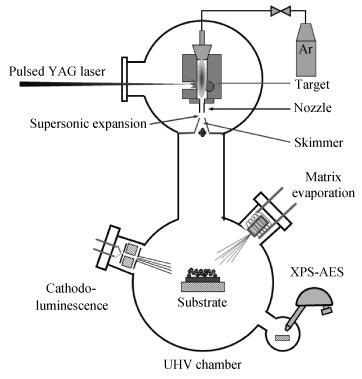
 DownLoad:
DownLoad:
